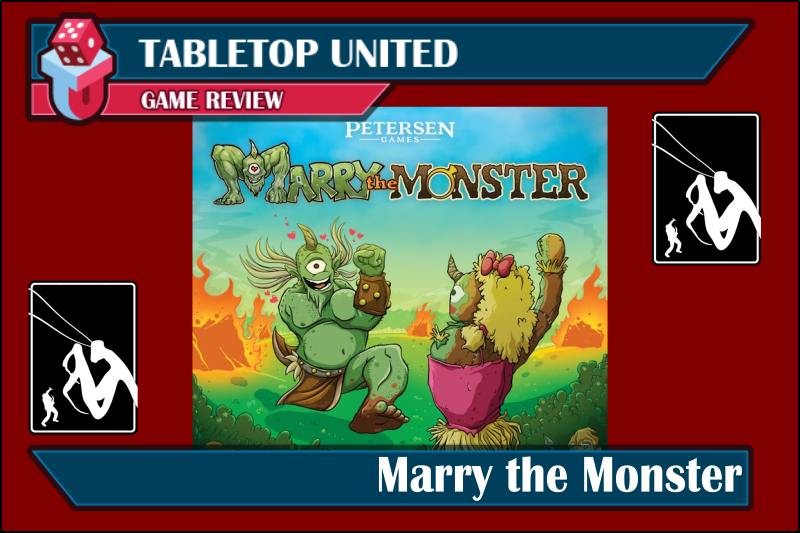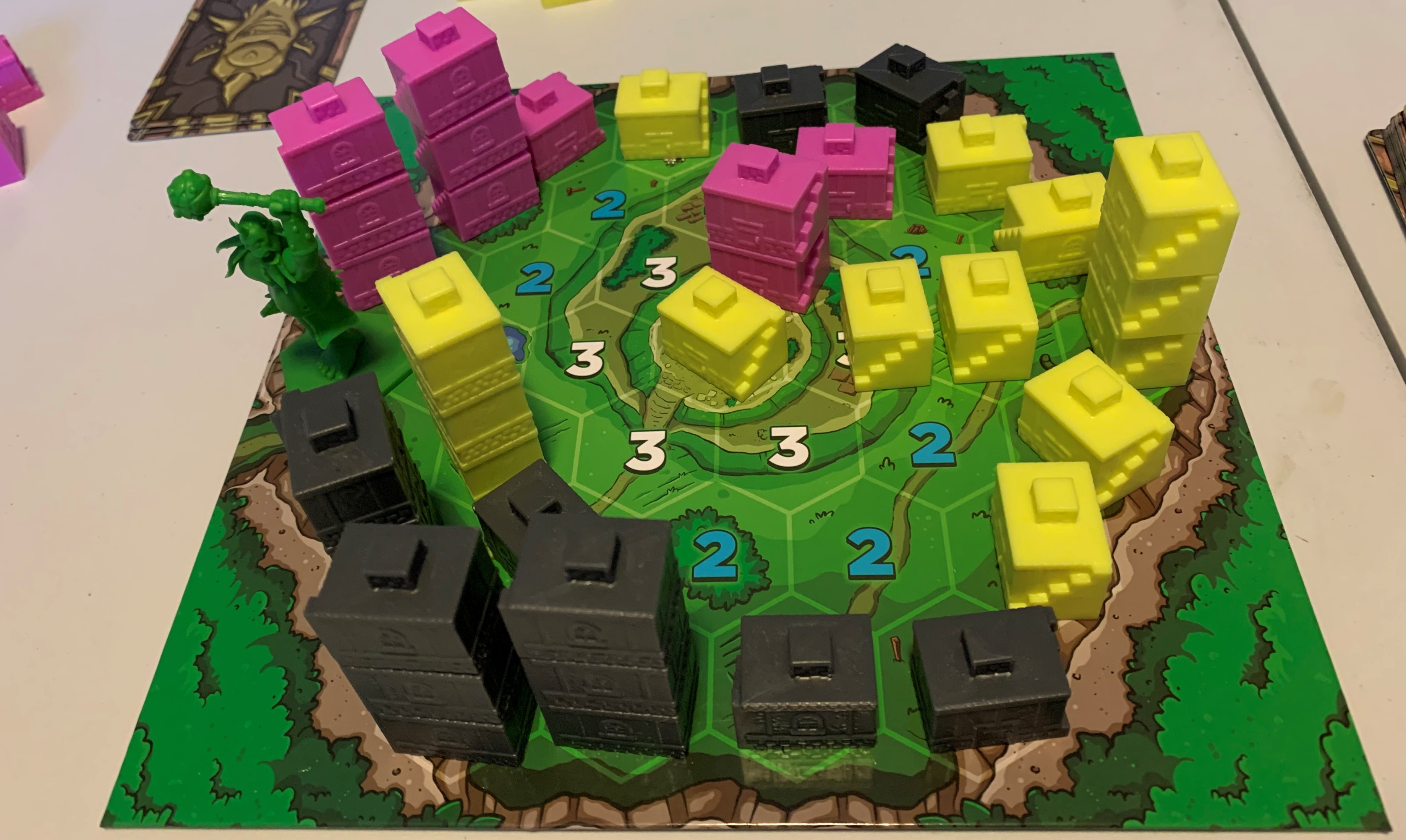
Marry the Monster
Designer: Zoran Dobrijevic, Arthur Petersen
Artist: Brian Patterson
Publisher: Petersen Games
Year Published: 2021
No. of Players: 3–5
Ages: 14+
Playing Time: 30–45 Minutes
Main mechanic / Theme: Hex Grid controlled Movement, Hand Management / Folklore, Fantasy
Love can be a monster that needs to be controlled.
Find more info on BoardGameGeek.com.
Overview
Marry the Monster provides a great strategy variation. The rules are easy to read and quick to learn. Like so many good strategy games it comes out in the playing of the game. The game uses a hexagon map in which you move the fachan, a giant, from Scottish folklore, in position to stomp buildings.
We sat down to play a three-player game and were able to play within a few minutes after absorbing the rules and objective. Game play proceeded easily and quickly with almost no need to refer back to the rules on our first game. Testing strategies are something we are going to have to have more games to figure out, but everyone enjoyed the outcome.
Younger players familiar with different types of strategy games will be able to enjoy Marry the Monster—especially if they have played games using a hex map. The design allows for the game to push itself into an end game to keep it from extending out overly long.

Gameplay and mechanics
Setup for Marry the Monster is simply placing the fachan in the center of the board, giving each player their buildings, and dealing three cards to each person.
The endgame objective is just as simple. A player wins when they have three towers on the board (a building of three levels high) and 45 points.
The rounds are divided into five steps.
Step One: Score Points
Add up the point value on the space of each of your buildings. This gives your opponents time to counter your placement in step three.
Step Two: Draw One Card
Hands don’t have size limits. This can be used as a strategy.
Step Three: Build
At the start of the game you can place up to three houses in unoccupied places on the board. The edge of board is easier to hold, but those spaces are only worth one point. As you move towards the center, the point value goes up. The center space, where the fachan starts, has a value of five.
As you score more points, the number of free buildings decreases. When that happens, you have additional actions you can take. I’ll talk about those later.
Step Four: Move the Fachan and Play Cards
You have one free move of the fachan along the hex map in a straight line. There are some limitations based on the placement of buildings for your free move. This free movement can be done before, after, or between playing cards. This is when you set up the fachan to work with your cards to Stomp buildings.
The deck of cards is made of three different types of cards.
Build Cards
These cards are used to place two additional buildings into empty spaces on the board. This can be used for scoring or strategy to protect your buildings and limiting the movement of the fachan.
Fortify Cards
These cards are used to expand buildings already on the board. You start out by placing a house on an empty hex. The first Fortify Card makes it a Manor and the second card makes it a Tower. A Tower is as high as you can build.
Fortifications make buildings harder to be destroyed by the fachan, and you must have three Towers on the board to win the game.
Stomp Cards
You play Stomp Cards to have the fachan move from his current location to another in a straight line, destroying all of the eligible buildings in his path. If you play a single Stomp Card, he will destroy all of the Houses in his path. Two Stomp Cards has him destroying all Manors and Houses. Three Stomp Cards means he destroys all the buildings in his path.
A couple of rules apply to playing cards. You can play as many Build and Fortify Cards as you want on your turn. Stomp Cards are limited to how many times you can persuade the fachan to stomp. The number of times and the control of where he stomps changes as your score increases.
You can also play a set of three cards of one type to be used as a card of another type. During our game, one player forgot about that rule and it may have significantly changed the outcome of the game.
If you choose not to play any cards, you draw three cards.
Step Five: Draw Cards for Stomped Buildings
For each building the fachan Stomped on your turn, draw one card. For drawing cards, a House, Manor, and Tower are all equal. You draw one card for each building, not for construction units removed from the board.
Now it is the next player’s turn. The game ends as soon as a player obtains the objective.

Theme and Artwork
Marry the Monster uses a fantasy theme based on the half-man giant of Scottish folklore. The rulebook provides a backstory and explains how the Blue Wizard has determined what is needed to stop the rampaging fachan. Along the way, he provides books to the players as they are successful in their mission of building their village.
Brian Patterson provides the artwork for Marry the Monster. This game isn’t heavy on art, but what is provided is a great fit for the story.
The rulebook’s layout was easy to read and allowed for quick referencing.
What worked
The movement and stomping strategy had us thinking on a different level. It was not only about where to do your stomping, but how to best protect your buildings form the stomping of other players.
Final thoughts
All of us had fun playing Marry the Monster. We liked the simple rules and allowed the strategy of the game to come through in the movement and card play. We also liked how the variability of the cards and movement of the fachan allows for enough variability to make Marry the Monster a game you would want to play back-to-back.
I recommend Marry the Monster to players who like
- Shorter strategy games
- Games based on Folklore
- Stomping you opponents

About the Author
Daniel Yocom does geeky things at night because his day job won't let him. This dates back to the 1960s through games, books, movies, and stranger things better shared in small groups. He's written hundreds of articles about these topics for his own blog, other websites, and magazines after extensive research along with short stories. His research includes attending conventions, sharing on panels and presentations, and road-tripping with his wife. Join him at guildmastergaming.blogspot.com.

